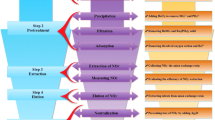
Overview
- Presents instructions on how to extract, purify, provide modifications, during the purification protocol process
- Provides examples of δ18OP studies in sediments, soils, fresh water, mineral fertilizers and plants
- Describes the five stepwise purification of extracts and final precipitation of silver phosphate (A1 to A5)
- This book is open access which means that there is free and unlimited access
Buy print copy
Tax calculation will be finalised at checkout
About this book
This open access book distinguished itself from other publications by offering step-by-step instructions on how to extract, purify, provide modifications, and major issues to be encountered during the process. For the δ18OP method to progress, further fundamental research as well as field and laboratory studies need to be conducted for a better understanding of P cycling in the environment. Chapter 1 outlines the background and examples of δ18Op studies in sediments, soils, fresh water, mineral fertilizers, and plants. Chapters 2 and 3 examine the stepwise extraction and purification protocols including reagents, equipment and consumables and preparations for analyses. Chapter 4 examines some of the challenges and modifications during the purification process. Chapter 5 discusses planning and designing of a study using δ18Op, external quality assurance with an example of an inter-laboratory study. Chapter 6 outlines the conclusions, future trends, and opportunities, the scaling out of the method from laboratory to field studies. It is expected that the δ18OP would be extensively applied in research geared to understand phosphorus dynamics in different agro-environments.
Similar content being viewed by others
Keywords
Table of contents (6 chapters)
Editors and Affiliations
About the editors
Joseph Adu-Gyamfi, Soil and Water Management and Crop Nutrition (SWMCN) Section, Joint FAO/IAEA Centre of Nuclear Techniques in Food and Agriculture, International Atomic Energy Agency (IAEA), Vienna, Austria
He is working as Integrated Soil Fertility Management Officer providing technical assistance to IAEA national, regional/interregional technical cooperation projects in in Africa, Asia, Europe, Latin America, and the Caribbean, on the use of multi-stable isotope fingerprints to identify sources and transport of contaminants in the environment. His work involved developing climate-smart agricultural practices to combat and mitigate the impacts of climate change on agricultural systems and food security, soil and water quality in developing countries. Prior to joining the SWMCN Section, he has 30 years’ experience in the use of isotopes to measure and monitor interactions between soil, water, and nutrients in cropping systems at different research, academic, development consultant firms, national and international organizations in both developing and developed countries. He is Author and Coauthor of 3 books, several chapters, and research publications in refereed journals. He has won several awards for his professional achievements including the ICRISAT Outstanding Research Scientist 2002, special award on Root Research on Drylands (Japanese Society of Root Research), IAEA Superior Achievement Award in 2018.
Verena Pfahler, Smithsonian Tropical Research Institute, Balboa, Ancon, Panama. Her area of expertise includes phosphorus dynamics and impacts in the environment and the use of stable and radioisotopes in environmental studies. She is Postdoctoral Research Fellow focusing on phosphorus cycling in the soil/plant system and P cycling in agricultural systems, alternative P fertilizers, and using oxygen isotopes associated with P (δ18OP) to study P cycling. She has over ten years of experience in using the δ18Op protocol and adapting it to different soil and plant extracts and is Coauthor of one chapter and 13 peer review journal papers. Her recent work includes P cycling in tropical rainforests using the δ18OP method.
Bibliographic Information
Book Title: Oxygen Isotopes of Inorganic Phosphate in Environmental Samples
Book Subtitle: Purification and Analysis
Editors: Joseph Adu-Gyamfi, Verena Pfahler
DOI: https://doi.org/10.1007/978-3-030-97497-8
Publisher: Springer Cham
eBook Packages: Earth and Environmental Science, Earth and Environmental Science (R0)
Copyright Information: IAEA: International Atomic Energy Agency 2022
Hardcover ISBN: 978-3-030-97496-1Published: 19 April 2022
Softcover ISBN: 978-3-030-97499-2Published: 17 April 2022
eBook ISBN: 978-3-030-97497-8Published: 16 April 2022
Edition Number: 1
Number of Pages: VII, 64
Number of Illustrations: 3 b/w illustrations, 6 illustrations in colour
Topics: Environmental Management, Monitoring/Environmental Analysis, Analytical Chemistry, Water, general, Agriculture, Pollution, general



